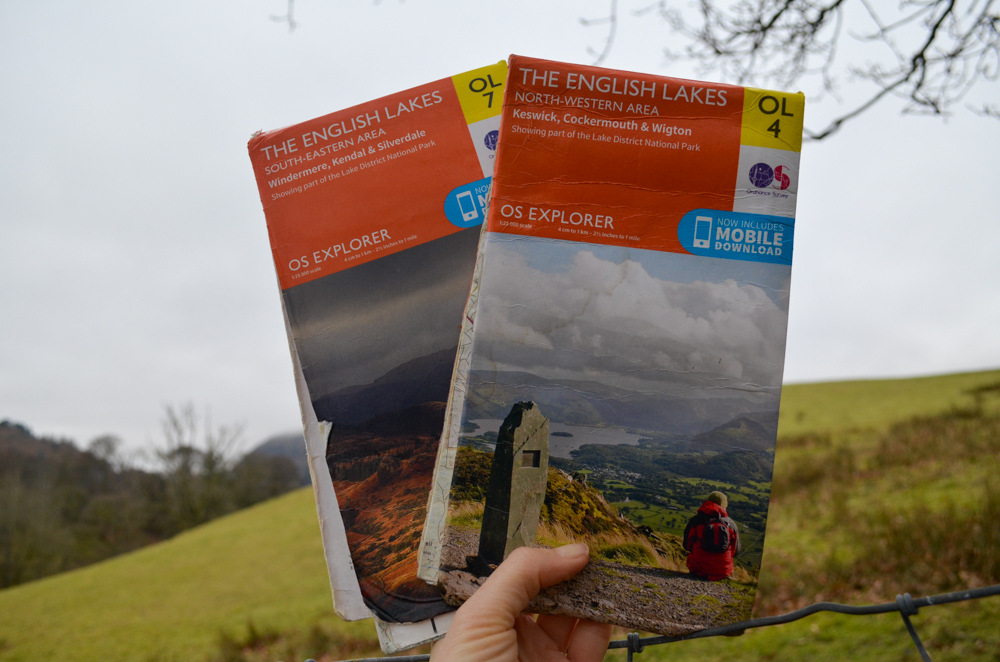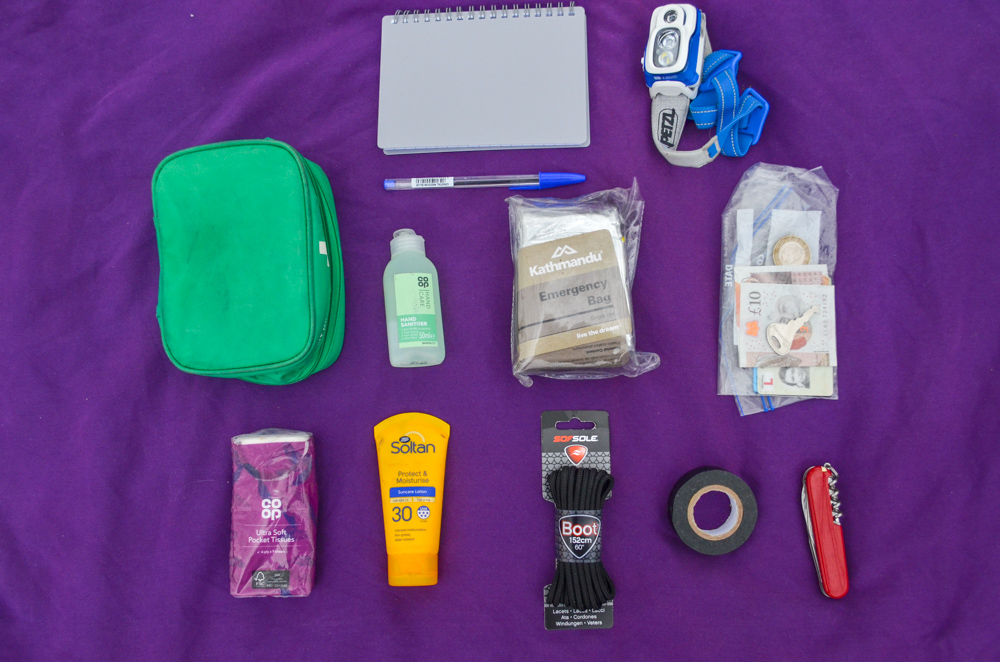Heading out into the hills is one of the best ways to soak in and experience the beauty and drama of the Lake District. But what do you need to pack to make sure you have an enjoyable and safe day walk in the Lake District?
After almost three years of living in the Lake District, I have tweaked my packing list over the years – adding things like a portable phone charger and cash after missing the last bus out of the Buttermere valley!
As a general rule of thumb, this is the kit I would take if I knew I was hiking anything over 350m during spring, summer, autumn and milder winter days (for snowy mountain days a more robust kit is needed).
The key to walking in the Lake District is just to be prepared for changeable weather – even summer days can start off warm and sunny and end in downpours – so for maximum enjoyment, it’s good to head out prepared.
These are my absolute essentials for a day walk in the Lake District.
The Essentials
A sturdy, comfortable rucksack


A decent rucksack is an absolute essential on a full day walk in the Lake District, to carry waterproofs, spare kit, food and drink. Opt for one with plenty of space and make sure it’s comfortable before taking it out for longer hikes.
I absolutely love this Osprey Tempest 33L backpack I bought when I moved to the Lakes, designed for smaller women it’s super comfortable with plenty of adjustment straps and handy pockets including a stuff sack in the front for easy access to waterproofs and even small zip pockets on the comfy hip buckle perfect for snacks.
Waterproofs (even in summer)


The most essential item for a hike here – even in summer! Check the forecast before setting off and even if you think there is little chance of rain, pack a thin, lightweight jacket as random unexpected showers are common and there’s nothing more miserable than being wet on a day hike.
My waterproof trousers are a value pair from Sports Direct which aren’t bad but I’m looking to invest in a sturdier pair as I progress to longer hikes.
This Columbia jacket I amazingly picked up from a gear sale at Keswick Mountain Festival for £10! It’s slightly too big for me, but I’ve actually found that useful as I can layer up with a thicker jacket in winter.
Extra layers and socks

Another essential for the notoriously changeable Lake District weather. I always take a thin long sleeve top and jumper (thicker in winter). Bear in mind that for every 100m you climb, it’s around 1-degree cooler – so whilst it might be toasty warm in the valley, it can be up to 5-6 degrees cooler at the summit.
It’s always handy to have a spare bare of socks in case of bogs or misjudged stream crossings!
Hat and gloves

Generally, these are in my kit bag between September – May but even in summer if I know I’m going above around 600m or the forecast isn’t great these will be packed.
In winter I’ll also take a thicker hat and ski gloves I can swap out for these thinner lightweight options when the temperature drops.
Map and compass/navigation system

A map is essential if you are heading out into the hills of the Lake District, plus being familiar with how to use one.
The weather can be extremely changeable at times with clouds suddenly descending, it’s easy to become disorientated and lost. I have the OS maps app (around £24 for the year) on my phone but I still always take my paper OS map (of which there are 4 main ones that cover the Lakes) as a backup in case my phone gets lost or broken.
The Ordnance Survey have this great collection of videos and articles on map reading for beginners here.
Food, drink and snacks

The best bit of kit 😛 If I’m on a day hike I will usually bring a packed lunch with me (unless a know I’ll be eating out before or after the hike).
I’ll always bring plenty of snacks – nuts and energy bars and a few more “emergency one” in case of getting injured or lost on the hill – because being hungry on the hill is the worst.
In winter, I’ll often bring a flask of soup or hot chocolate to warm me up and my water bottle which I tend to fill up in fast-moving steams if need be.
Useful and emergency kit

These are bits of kit which don’t often get used but which I carry in case of emergency:
- A first aid kit – typically with plasters, blister plasters, a small bandage, antiseptic wipes, painkillers and antihistamines
- Tissues and hand sanitiser
- Suncream (and glasses) – even in winter
- An emergency blanket in case myself or someone else gets injured
- A fully charged headtorch – even in summer in case of extending routes or emergencies on the hill
- My ID, bank cards and spare cash in a waterproof bag – some places smaller places in the Lakes only take cash (and useful for parking) plus I carry it in case of needing an emergency taxi after the last bus as gone!
- Spare boot laces – mainly because my boots are quite old now but it’s useful to fix broken kit
- Gaffer tape – good for fixing unexpected tears and holes
- A pen knife – for picnics, fixing things or a bottle opener!
- A pen and paper – mainly for if I get inspired to write ideas or thoughts (which I often do hiking solo) but also in case of needing to make hitchike signs or note down details in an emergency
- Phone and portable charger (not pictured)
- Spare plastic bags – for my rubbish/rubbish I see en route, to store any wet kit in and to use to sit on wet ground!
Extra kit I find useful
Walking poles

Some people love them, some people hate them. As someone with questionable balance (and a bowed leg which has led to a curve on my foot) I find them brilliant on the hill and now wouldn’t be without them. They take the weight off my knees during descents, too.
I picked up these from Alpkit for around £40 – lightweight, easy to use and retract down to easily tuck into my backpack.
When using public transport – Book/headphones & bus timetable

As I don’t drive and get to most of my hikes on the bus, I’ll usually bring a book and headphones to keep me entertained en route. Also, in the more rural parts of the Lakes, some buses only run every 2 hours so provide post-hike entertainment!
I always have a spare copy of the bus timetable for the season too (note there is a different one between winter and summer)
I hope you have found this guide useful and you thoroughly enjoy your day walk in the Lake District! If you have any further questions, feel free to message me on Instagram
Join my monthly Letters from the Lake District newsletter
Each month, I share…
✨A mini letter from me with monthly insights into living in the Lake District
✨ Books, podcasts, essays and articles from the Lake District and outdoor community to inspire you

Leave a Reply